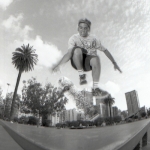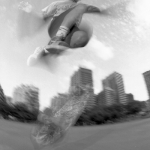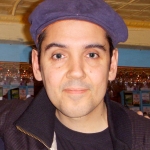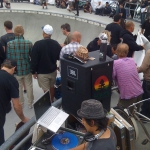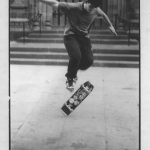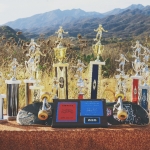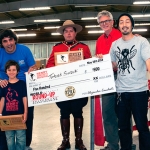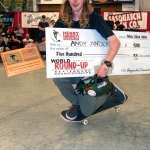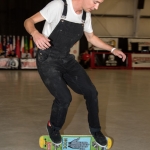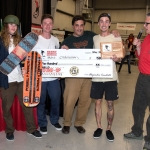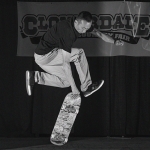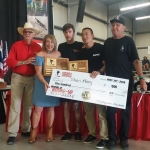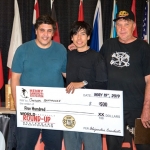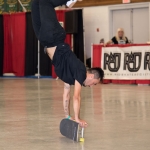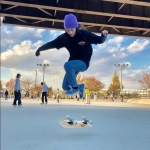 Enrique “Henry” Candioti was born in London, England on June 23, 1965. The son of an Argentine diplomat, his family lived in London, Bonn, Geneva and Buenos Aires before moving permanently to the U.S. when his father, also named Enrique, was appointed ambassador of Argentina. Enrique “Henry” Candioti was born in London, England on June 23, 1965. The son of an Argentine diplomat, his family lived in London, Bonn, Geneva and Buenos Aires before moving permanently to the U.S. when his father, also named Enrique, was appointed ambassador of Argentina.
He started skating in 1977 at the age of 12 and soon recognized his gifted ability for freestyle, probably inherited from his mother Mary, who as a teen had been a ballet dancer and an incredible roller skater as well. One of Henry’s first skateboards was an orange Powell-Peralta Beamer, which was totally unsuitable for freestyle but he kept practicing anyway. In the spring of 1979 on a trip to London, he dragged his family to a small apartment on the South Bank to buy a Benjyboard, the legendary British brand ridden by local skaters such as Jeremy Henderson and Mark Sinclair. Later, Henry would order freestyle decks by mail from the classic Val Surf ads in SkateBoarder Magazine. He also received the Bones Brigades Intelligence Reports, which at the time included sequence photography of Rodney Mullen’s tricks, and he exchanged various letters with Rodney and Stacy Peralta. As there were no videotapes at the time to learn from, he had to look carefully at the pictures in the Intelligence Reports to figure out how tricks were done. Henry also loved to ride vert, but because there were no skateparks in Germany or Argentina, he and his brother had to build their own ramps. During his teenage years, Henry built a dozen ramps, quarter pipes and half pipes, which he would use on the sidewalk of their home at the American housing project in Plittersdorf, Germany. Every month, the local police would come with a crane and remove his ramp for illegally occupying the public domain. But that didn’t deter Henry and he just kept building new ramps for almost two years. After living in Europe for several years, his family returned to Buenos Aires in 1981. At that time freestyle skateboarding was virtually non-existent there and Henry really stood out. Because of his father’s job he was able to obtain copies of SkateBoarder, Thrasher and TransWorld Skateboarding magazines, as well as all the California skate music, and later the first Bones Brigade videos which he shared with everyone. |
With his new Argentine skate friends, he built the first half pipe in Buenos Aires, located at the School of Architecture at the University of Buenos Aires. Henry’s half pipe would later become the venue of various sponsored events in Argentina.
In 1986, he moved to the U.S. with his parents; first to Washington, DC, then to Providence, RI, where he studied architecture at the Rhode Island School of Design. Renowned street artist Shepard Fairey, also a skater, was Henry’s roommate at RISD. During his time at school, he further developed his skating and became close friends with Terry Synnott who told us, “He has always been my favourite skater. He flowed in a way that was so uniquely his own. Because he started skating in the late 70s, away from the California epicentre of skateboarding, he learned to skate by seeing photos in magazines and then imagining how they got into those positions. He was a true original.” It was during this time period that he started to compete nationwide as an amateur at freestyle contests using the name of Henry Candioti. His talents landed him sponsorship from Vans, Independent Trucks, OJ Wheels and the Watershed Surf Shop. Henry loved surfing and it was his childhood dream to live in California, something he finally fulfilled when he moved there in 2003 with his wife Tiffany and their son Sebastian. Henry was a raw vegetarian, and in addition to working as an Art Director at the Ventura County Reporter, he made and sold raw vegan ice cream at the Ojai Farmer’s Market on Sundays. Reggae music was also a big part of Henry’s life and he became a Reggae DJ; a passion he pursued for twenty years under the name “DJ Ambassador Jr.” He made tapes and mixes that were actually sold in Jamaica. He also performed with fellow DJs and skaters Isaac Nichelson and Bennett Harada at several events organized by the Bob Marley family in Aspen and Las Vegas, and at contests at the Venice Beach skatepark. Tragically, in November of 2011 Henry was diagnosed with stage 4 kidney cancer, a silent killer. Henry remained cool and positive and enjoyed life, music, and being with his family and friends until the very end. Henry may be gone, but his effortless skating style lives on through the many photos and videos of him skating. The skaters in Argentina consider Henry as one of the most influential skaters of all time. |

